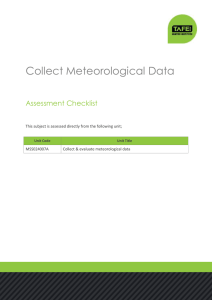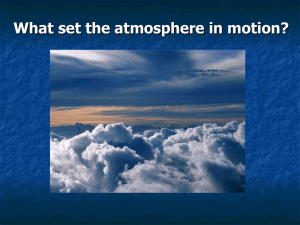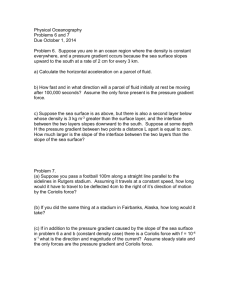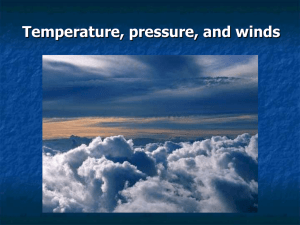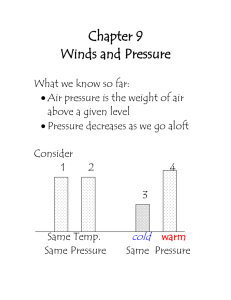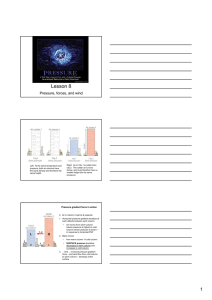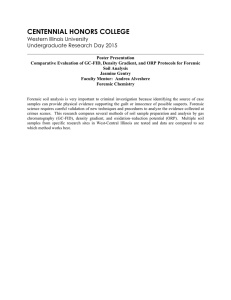Collect & evaluate meteorological data Study module 4
advertisement
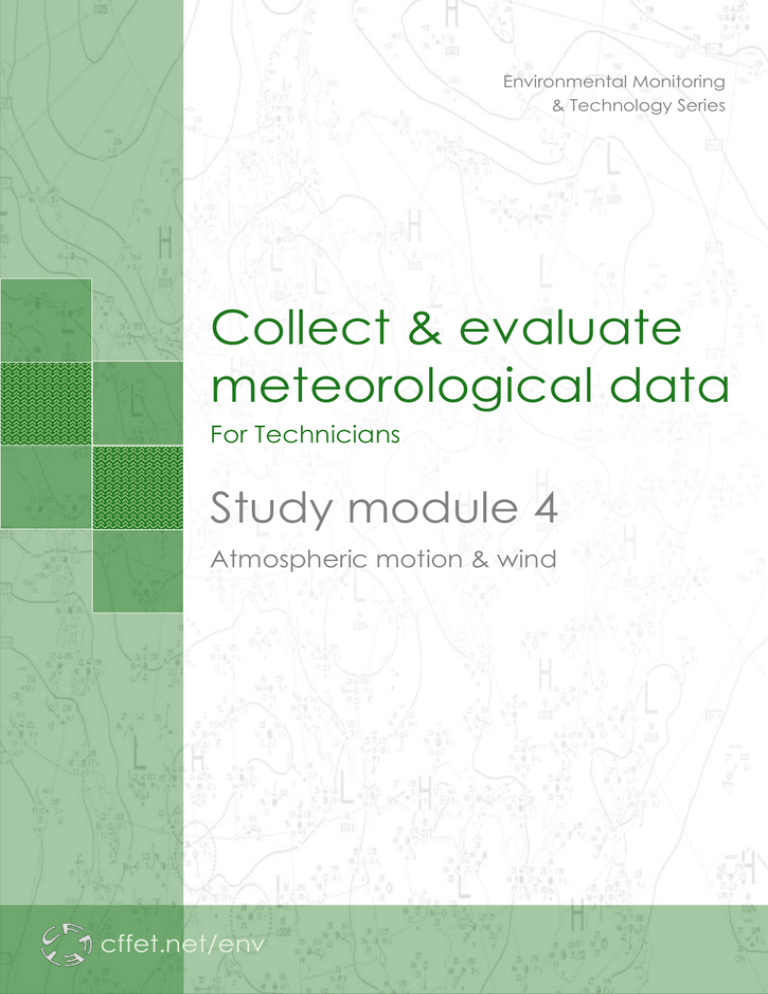
Environmental Monitoring & Technology Series Collect & evaluate meteorological data For Technicians Study module 4 Atmospheric motion & wind cffet.net/env Collect & evaluate meteorological data Study Module 4 Assessment details Purpose This subject covers the ability to site and set up basic ‘ground level’ meteorological equipment and collect and record reliable data. It also includes the ability to assess data quality, interpret significant data features and use the data to ensure the validity of air and noise monitoring measurements. Instructions ◗ Read the theory section to understand the topic. ◗ Complete the Student Declaration below prior to starting. ◗ Attempt to answer the questions and perform any associated tasks. ◗ Email, phone, book appointment or otherwise ask your teacher for help if required. ◗ When completed, submit task by email using rules found on last page. Student declaration I have read, agree to comply with and declare that; ◗ I know how to get assistance from my assessor if needed… ☐ ◗ I have read and understood the SAG for this subject/unit… ☐ ◗ I know the due date for this assessment task… ☐ ◗ I understand how to complete this assessment task… ☐ ◗ I understand how this assessment task is weighted… ☐ ◗ I declare that this work, when submitted, is my own… ☐ Details Student name Type your name here Assessor Marker’s use only Class code CMD Assessment name SM4 Due Date Speak with your assessor Total Marks Available 73 Marks Gained Marker’s use only Final Mark (%) Marker’s use only Marker’s Initials Marker’s use only Date Marked Click here to enter a date. Weighting This is one of seven formative assessments that make up 20% of the overall mark for this unit Hunter TAFE - Chemical, Forensic, Food & Environmental Technology [cffet.net] Course Notes for delivery of MSS11 Sustainability Training Package Page | 1 Collect & evaluate meteorological data Study Module 4 Atmospheric motion & wind We are all familiar with the notion, and motion, of wind. But what exactly is it? What causes it? How does wind differ when we change the scale of our surroundings? These are the types of questions that will be answered in this chapter. It was mentioned in Chapter 1 that the weather plays an enormous part in our lives for many reasons, especially in Australia where the ‘outdoors’ is a cherished component of our lifestyle. So, along with temperature and precipitation, wind is a major factor in determining whether we are enjoying ourselves, or whether our lives are being blown apart by a cyclone. Once again we find that scale is very important when examining meteorological phenomena and we find that there are different types of winds, along with different causes, for each of the global, synoptic, regional and micro scales. Exercise 4.1 Complete the Important Terms found at the end of this Chapter before continuing to aid your comprehension Horizontal motion High & low pressure systems The concept of how pressure changes in a vertical column through the atmosphere was mentioned in Chapter 3, and we now need to apply that concept to the air around us on the horizontal surface of the Earth. High Pressure Systems A high pressure system results from the subsidence (falling) of air. For air to fall, it must lack buoyancy, and therefore be denser (i.e. cooler) than the air around it. When the air parcel subsides to the ground, it cannot go further, and therefore it diverges along the surface of the Earth in much the same way that water would if it was poured onto the ground, as seen in the figure below. Figure 4.1 – The formation of a high pressure system from the subsidence of dense, cool air. Hunter TAFE - Chemical, Forensic, Food & Environmental Technology [cffet.net] Course Notes for delivery of MSS11 Sustainability Training Package Page | 2 Collect & evaluate meteorological data Study Module 4 A high pressure system generally exhibits dry, very stable conditions with slight breezes. These pressure systems create the perfect sunny days that we crave in both winter and summer Low Pressure Systems You may have guessed that is a high pressure system results from falling air, then a low pressure system must therefore result from rising air. For air to rise, it must exhibit buoyancy, and be less dense (i.e. hotter) than the surrounding air. Such circumstances are easily obtained when the sunlight heats the air. Figure 4.2 below shows how this happens. Figure 4.2 – Formation of a low pressure system as a result of rising, buoyant air. Low pressure systems usually result in wet, cool, unstable weather and are renowned for ruining a good weekend (or in my case, ecology field trips). So, basically, we have a situation where the air molecules above the ground create a pressure on the Earth’s surface (called Mean Sea Level Pressure), which on average is equal to 1013.25 hectopascals. The problem is that this pressure measurement is not the same all over the surface of the Earth, the pressure is different at different locations relative (meaning, when related to…) the average value of 1013.25 hPa! The important question therefore becomes “Why does the air pressure differ over the Earth’s surface?” Fortunately, the answer is quite simple! Figure 4.3 – Example of how the spherical curvature of the Earth allows more of the Sun’s light energy to reach the equator per unit of area than at the poles. Hunter TAFE - Chemical, Forensic, Food & Environmental Technology [cffet.net] Course Notes for delivery of MSS11 Sustainability Training Package Page | 3 Collect & evaluate meteorological data Study Module 4 In an earlier module we learnt about the physical attributes of the Sun and the Earth. As the Earth is a sphere (technically, an oblique spheroid), the Sun’s light does not shine on the whole surface of the Earth ‘evenly’. As a result, the Equator is delivered more of the Sun’s energy per unit of area than the poles, as demonstrated in the figure 4.3 above. The result of this uneven distribution of the Sun’s energy means that there is a temperature gradient stretching from the north and south poles (relatively cold) to the equator (relatively warm). Figure 4.4 – Graph of data showing latitudinal temperature profile of ambient air. Data was adapted from graphs used by the US National Center for Atmospheric Research (NCAR). Such a temperature gradient obviously causes the air at the equator to heat up quicker, and to higher temperatures, which means that the equatorial belt is in a relatively constant state of low pressure. But what happens to the rising air? Longitudinal Atmospheric Motion Warm, moist air that rises in the equator (in what is called the Inter-tropical Convergence Zone, or ITCZ) reaches troposphere heights where it hits a virtual ‘ceiling’ called the tropopause, slowly cooling as it does so. This blocks the upward movement and the air, which is forced to move either north or south (it cannot fall on top of itself as the air is constantly rising underneath it). The air continues on its path towards the poles until it starts to fall again at approximately 25-30° latitude. This falling air causes a belt of high pressure systems (called the mid-latitude highs) when it diverges on the surface where the air and is either ‘sucked’ back into the equator becoming part of the trade winds to replace the air that is rising, or diverges toward the poles as a westerly wind. Hunter TAFE - Chemical, Forensic, Food & Environmental Technology [cffet.net] Course Notes for delivery of MSS11 Sustainability Training Package Page | 4 Collect & evaluate meteorological data Study Module 4 This cycle of rising, moving and falling air is called the Hadley cycle (named after the person who suggested its existence), and it does more than move around. As mentioned earlier, when the air rises, it cools down (for reasons explained later), and any moisture in the air mass (as humidity) condenses out and becomes rain. What this does is dry out the air that moves north and south, creating phenomena known as mid-latitude desertification. The whole process is shown in the Figure 4.5 below. Figure 4.5 – Mechanism of the Hadley Cell. Although only one cell is shown, they are the same for both hemispheres. Figure 4.6 – Latitudinal circulation of the atmosphere showing the three ‘super-cells’, the Hadley, Ferrel and Polar, as well as the East and West flowing Jet Streams. Hunter TAFE - Chemical, Forensic, Food & Environmental Technology [cffet.net] Course Notes for delivery of MSS11 Sustainability Training Package Page | 5 Collect & evaluate meteorological data Study Module 4 The Hadley cell is one of three major latitudinal cells that control the distribution of high and low pressure systems on Earth. The second cell is called the Ferrel Cell and its winds move in the opposite direction to the Hadley (in the same way that two meshed gears operate). Finally, there is a Polar Cell, whose direction is opposite the Ferrel Cell (and therefore exhibits the same north/south flow as the Hadley Cell). These three ‘super-cells’ go a long way in explaining the presence of high and low pressure systems due to the subsidence of air at the boundaries of each cell. This results in a global semi-permanent pattern of high and low pressure areas, one of which has already been mentioned, the mid-latitude highs. Overall, we observe low pressure systems at the equator (0° latitude), and in the sub-polar low pressure belts located at approximately 60° north and south. We observe high pressure systems at the poles (90°) and in the mid-latitudes at 25-30 ° latitude north and south. The overall picture is best explained by Figure 4.6 above. Latitudinal Atmospheric Motion It is not only the longitudes that see dramatic circulations of air masses. A very similar phenomenon occurs latitudinally as well. The most significant of these is the Walker Circulation and the Jet Streams (not forgetting the winds at the surface, but these come in detail later!). Figure 4.7 – The global Walker circulation. From https://www.meted.ucar.edu The Walker Circulation is described as being thermally driven, as opposed to the HadleyFerrel-Polar cells which are temperature gradient driven. This circulation consists of three super-cells that cover the entire equator, with each cell stemming from one of three major lands; the Central Americas, Africa (Middle East) and Australasia. Generally speaking, to make something move, we need a phenomenon called force, and for simplicities sake, we shall view force as a simple kind of energy. The primary forces which affect horizontal motion are; Hunter TAFE - Chemical, Forensic, Food & Environmental Technology [cffet.net] Course Notes for delivery of MSS11 Sustainability Training Package Page | 6 Collect & evaluate meteorological data Study Module 4 ◗ Pressure gradient force (PGF) which is a consequence of a pressure gradient ◗ Coriolis force which is a consequence of the rotation of the Earth ◗ Friction force which is a consequence of the roughness of the Earth surface and the difference between solid Earth and the gaseous atmosphere. Pressure Gradient The distribution of pressure in the atmosphere is not the same all over on the surface of the Earth, nor is it the same through a vertical slice of the atmosphere (which you would already know due to the high and low pressure systems you observe on weather charts). The increase in pressure over a distance is called a pressure gradient. A pressure gradient has two significant attributes – magnitude and direction; ◗ Magnitude The magnitude is based on the distance between the high and low pressure centers, and how strong the high and low pressure centers are. This results to an increase in the magnitude of the pressure gradient if the distance between high and low pressure systems is close, and the pressure difference between high and low pressure systems is large, and a decrease in the pressure gradient when the opposite applies. Figure 4.8 – Pressure Gradient shown for air pressure readings at sea level ◗ Direction The pressure gradient points from centres of lower pressure toward centres of higher pressure, as shown in Figure 4.7 above. Pressure Gradient Force (PGF) The pressure gradient is associated with the Pressure Gradient Force, or PGF. Its magnitude is directly proportional to the magnitude of the pressure gradient, but its direction is the Hunter TAFE - Chemical, Forensic, Food & Environmental Technology [cffet.net] Course Notes for delivery of MSS11 Sustainability Training Package Page | 7 Collect & evaluate meteorological data Study Module 4 opposite. We know heat moves from an area of higher temperature to the area of lower temperature so does pressure behaves similarly. Pressure is directed from areas of higher pressure toward areas of lower pressure. The pressure here is a measure of air pressure, so the pressure gradient force drives air outward from high pressure regions to low pressure regions. You should notice from Figure 4.8 below that the pressure gradient force is perpendicular to the isobars (the black lines). If the isobars (lines of equal pressure) were closer together, then the PGF would be greater, and the wind would blow harder. Figure 4.2 implies that the PGF forces the air to ‘fall’ in a straight line from the high to the low pressure system, and if the earth did not rotate, that is exactly what would happen. Horizontal air motion in the Southern Hemisphere sees the air spiral out of high pressure areas in an anti-clockwise direction and spirals into low pressure areas in a clockwise direction. This spiralling is due to the Coriolis force. Figure 4.9 – Relationship between of Pressure Gradient Force (PGF) to pressure systems as shown from perspective of a high pressure system Coriolis Force Any one point on the Earth’s surface completes one full rotation in a west-to-east direction in one day. This rotation creates the Coriolis Force. It is strange because it is based only on latitude, not any meteorological phenomena. The Coriolis force increases as latitude increases. At the equator, it has no effect on horizontal flow. Hunter TAFE - Chemical, Forensic, Food & Environmental Technology [cffet.net] Course Notes for delivery of MSS11 Sustainability Training Package Page | 8 Collect & evaluate meteorological data Study Module 4 The reason for this is simple, if you roll a ball across a disk, that ball will travel in a straight line. But if you spin the disk clockwise (like the earth, if you were looking down on the South Pole) then the ball will appear to curve. We say ‘appear’, because the ball actually goes straight, but you continue to move. Figure 4.10 – Effect of the Coriolis force on a ball rolling on a spinning disk. Dotted line shows where ball would end if disk is stationary. The Coriolis Force (and effect) was explained by Gaspard Coriolis who was inspired by the Foucault’s Pendulum phenomena, which proved (unconditionally) that the Earth does spin. Refer to the ‘What you need…’ section at the end of the chapter for more information on these discoverers. Figure 4.11 – Coriolis Effect from perspective of both North and South poles The atmosphere spins with the earth as though it were a solid body. If it didn't there would be extremely strong winds, particularly at the equator, where a point on the earth is moving at 1670 km/hr because of the earth's rotation. The deflections that are imperceptible for objects like footballs traveling short distances, but they are important over long distances. Any movement of the air relative to the earth is called wind. If a parcel of air at point X in the southern hemisphere moves towards the equator, it is moving to regions where the movement of the earth is greater and, to a person on the earth, the parcel of air will appear to be moving more slowly, and so have been deflected westward. Conversely, if the parcel of air moves toward the pole, it is moving to areas where the movement of the earth to the east is slower, and so the air is apparently deflected Hunter TAFE - Chemical, Forensic, Food & Environmental Technology [cffet.net] Course Notes for delivery of MSS11 Sustainability Training Package Page | 9 Collect & evaluate meteorological data Study Module 4 eastwards, once again to the left of its direction of motion. In the northern hemisphere, the deflections are to the right. Figure 4.12 – Another example of the Coriolis effect. The Coriolis force can therefore balance the pressure force so that, in the southern hemisphere, the air will flow clockwise around a centre of low pressure and anticlockwise around a centre of high pressure. When the Coriolis force and the pressure force are in balance, the wind blows along the isobars and not across them. This is called the 'geostrophic wind'. The geostrophic wind is a theoretical wind and is only an approximation to the actual wind, because in reality friction (the next topic), pressure differentiation and the proximity of nearby air masses with other physical and mechanical attributes all contribute to throw the approximated geostrophic wind ‘off course’. Having said that, the geostrophic wind is a reasonable approximation in middle latitudes, and a good approximation in high latitudes, but it is a poor approximation in the tropics where the Coriolis force is weak. Although the PGF is the primary force pushing the air from high to low pressure centres, it is the Coriolis force that makes air spiral out of high pressure systems and into low pressure systems. The PGF and the Coriolis forces play significant roles in atmospheric motion, but there is one more factor we need to consider, and that is the rough surface of the Earth. Friction Force Friction is a force which impedes motion. Because our atmosphere is not a vacuum, objects in motion will eventually slow down because of collision with other matter, and that fact that friction forces point opposite the direction of motion which slows an object down. Friction is based on two factors: the speed of the object in motion, and the relative viscosity of the fluid through which the object travels which means that friction is greater the denser the fluid. Friction is an important force on air near the surface because of the rough terrain, but is insignificant above about 1 km. Therefore, the layer of air in which friction is important is known as the friction layer. The air above the friction layer is known as the free Hunter TAFE - Chemical, Forensic, Food & Environmental Technology [cffet.net] Course Notes for delivery of MSS11 Sustainability Training Package Page | 10 Collect & evaluate meteorological data Study Module 4 atmosphere because there is no significant friction. The height of the friction layer varies greatly, but is usually between 1 and 2 km. The friction layer is also known as the atmospheric boundary layer (ABL). But why is friction important? The reason is relatively simple to state, but horrifically complex to work out, so obviously we shall state it in very simple terms. Friction ‘stuffs up’ the whole balance of the other two forces (PGF and Coriolis) by undermining the Coriolis force. It does this because friction reduces the velocity (wind speed), which in turn reduces the Coriolis force, and if there is a balance between all three forces, and you reduce two of them, then the third one has to give out. Friction, Coriolis, and the PGF are summed together to get the net force placed on a parcel of air. If this net force is zero, there is said to be a balance of forces. If there is a net force greater than zero, then the parcel of air is said to have an acceleration. Figure 4.13 – Example of Friction Force at work. Due to the change of terrain, the air parcel is ‘stretched’ or ‘compressed’ resulting in either acceleration or deceleration which further leads to either divergence or convergence (see next chapter). Vertical Motion The second type of atmospheric motion is one less commonly ‘felt’ during weather events. Air doesn’t only move horizontally across a surface, but can also move vertically from the surface. There are three major forces that influence vertical motion; ◗ Vertical PGF ◗ Gravity ◗ Friction There are also three other factors influencing vertical motion; ◗ Convergence ◗ Buoyancy ◗ Terrain Hunter TAFE - Chemical, Forensic, Food & Environmental Technology [cffet.net] Course Notes for delivery of MSS11 Sustainability Training Package Page | 11 Collect & evaluate meteorological data Study Module 4 Vertical Pressure Gradient As mentioned above with wind formation, a pressure gradient is a change in pressure over a distance, directed towards the increasing values of pressure. It was also explained above that horizontal pressure changes are only relative to other locations of pressure (hence we have areas of relatively high and relatively low pressure). What hasn’t been explained is that pressure changes dramatically with height, forming a pressure gradient directed toward higher pressure values which are of course near the Earth’s surface. So, if the pressure gradient follows the direction of the increase in pressure, then there must be a very strong vertical pressure gradient force (VPGF) directed upward. The figure below shows the actual pressure gradient, as well as the directions of the gradient and the force. Figure 4.14 – Pressure / Height relationship showing vertical pressure gradient and force (indicated by arrows). Modified from Sturman and Tapper 1996 This pressure gradient is about four times larger in magnitude than the horizontal PGF. However, it is also balanced by gravity. Gravity Gravity is that familiar force that is produced by the earth (or any mass) and pulls all objects towards its center. Gravity causes an acceleration which is equal to the familiar 9.8 meters per second squared. This force is approximately the same magnitude as the vertical PGF, but points in the opposite direction and therefore produces a net force near zero. When gravity and the PGF perfectly balance each other, we call the situation hydrostatic equilibrium. Hunter TAFE - Chemical, Forensic, Food & Environmental Technology [cffet.net] Course Notes for delivery of MSS11 Sustainability Training Package Page | 12 Collect & evaluate meteorological data Study Module 4 Figure 4.15 – The cancellation of forces between the VPGF and gravity = 0 and result in a state known as hydrostatic equilibrium. Disruption to the equilibrium (which is never really reached at any one point in time or space) allows for vertical movement (up or down) of air masses. Friction Friction influences vertical motion just as it does horizontal motion. Friction works against motion. If a parcel is moving up, friction is directed downward, and vice versa. However, remember that parcels can reach a level where the frictional influence is approximately zero. This occurs in the free atmosphere above the friction layer. In the layer below the free atmosphere, friction plays a major role in air motion. Convergence We have mentioned that air spirals into low pressure centers due to the earth's spin. But where does the air go then? It cannot go into the ground, and so must compress and move upwards rapidly. The zone where the air meets is known as a convergence zone. Convergence can happen in the horizontal direction as well. Air converges at the surface in low pressure systems and diverges aloft. The opposite (divergence) takes place in high pressure system. Convergence is one method of vertical air motion. Buoyancy As air warms, it expands, becoming less dense. If the air around it is sufficiently denser, then the air parcel will become buoyant and rise, or "float" upward. Since density changes as temperature changes, the temperature profile of a layer is very important. If the surface is warm, and it is very cold aloft, then warming air parcels will be able to rise rapidly to great heights, since the temperature of the surrounding air decreases more rapidly than the temperature of the warm air parcel. Terrain The features of the land can also force air to move vertically. Let's use a mountain range as an example. Air moves across land and reaches a mountain range. Because it cannot go Hunter TAFE - Chemical, Forensic, Food & Environmental Technology [cffet.net] Course Notes for delivery of MSS11 Sustainability Training Package Page | 13 Collect & evaluate meteorological data Study Module 4 through the mountain, it must rise and go over the mountain. As the air rises, it cools. Once it moves over the range, it will sink and warm again. A mountain range is a large scale example, but the same scenario also holds true for smaller terrain features (hills, buildings, dog houses, etc.). Global scale motion From an early age you would have noticed yearly weather patterns; for the Hunter Region, you would notice, in winter, the arrival of regular ‘southerlies’, bringing cool and wet conditions for several days at a time and in summer you would notice the long, sunny dry days. Weather tends to follow some general patterns. These flow patterns are enormous, covering tens of thousands of square kilometers and affecting large parts of the world. When describing such a scale, it is termed a global scale. There are many patterns on the global scale which could be discussed but we shall focus on those patterns that most influence weather over Australia. The General Circulation of the Atmosphere General global air flow When examining the general flow of air around the globe, we need to examine both horizontal and vertical air flow. In Figure 4.6 we can clearly see the effects both of these types of wind movement. Figure 4.16 – General global circulation of the atmosphere showing both horizontal and vertical circulation patterns. After BoM Hunter TAFE - Chemical, Forensic, Food & Environmental Technology [cffet.net] Course Notes for delivery of MSS11 Sustainability Training Package Page | 14 Collect & evaluate meteorological data Study Module 4 So what are all these circulations? Figure 4.8 shows you the real scenario of global circulation on what we shall call an ‘average’. As you keep Figure 4.8 in mind, we shall examine the influences that create all of the circulations we see; ◗ Causes of horizontal motion (wind); ◗ The Earth is an oblique spheroid, a three dimensional squashed ball ◗ The Sun shines light at the Earth, which is distributed unevenly due to curvature ◗ The Earth warms more at the equator than at the poles creating a temperature gradient ◗ Heat rises at the equator, cools, and falls to the North and South of the equator The general flow of air over Australia In Australia, the wind generally flows from west to east and carries lows and highs from the west coast to the east coast over the course of several days. Notice that westerlies flow eastward. Instead of describing the direction the wind points, we use the direction from where the wind comes. This westerly motion is created by several factors including the Coriolis force and the jet streams as seen in the figure above. Jet Streams Jet streams are high speed air currents found at the top of the troposphere, often with wind speeds in excess of ~200 km/hr. These air streams are ribbons of high speed winds which have lengths of thousands of miles, but are only a few hundred kilometers wide and only a few kilometers thick. Figure 4.17 – Position of the jet streams in the atmosphere There are four primary jet streams on Earth; the subtropical jet streams and the polar jet streams. The subtropical jet streams form around 30°N&S latitude, where a general high pressure area exists. The sinking air over this area marks the boundary between moist, hot air to the south and cooler air to the north. Hunter TAFE - Chemical, Forensic, Food & Environmental Technology [cffet.net] Course Notes for delivery of MSS11 Sustainability Training Package Page | 15 Collect & evaluate meteorological data Study Module 4 Jet streams are important because they control the overall flow of air over the southern part of Australia. Bends and turns in the jet streams show us where weather systems are and where they are going. For example, there exist within jet streams areas of maximum wind speed called jet streaks. The location of these lead to the intensification of storm systems. It is the low and high pressure systems that are guided by jet streams and strengthened by jet streaks that cause our everyday weather. Synoptic scale motion The synoptic scale is the level just below the global scale. It is what we call the "weather map" scale because the highs, lows, and fronts that you see on weather maps fall into this scale. The synoptic scale encompasses regions thousands of kilometers in area with circulations that last from days to weeks. We will look at four major items on the synoptic scale: air masses, fronts, cyclones, and anticyclones. Air Masses An air mass is a very large body of air which has fairly uniform temperature and moisture properties throughout its horizontal extent, which may cover thousands of miles. Air masses originate in source regions, where the air is relatively stagnant and the air can acquire the properties of the source region. For example, the Australian north interior is a source region for the warm air that gives us our warm summers. An air mass that forms in the Antarctic region is what brings the middle to southern areas the cool changes (not to be confused with fronts). Figure 4.18 – Examples of some common air masses. After COMET Program (MetEd). Hunter TAFE - Chemical, Forensic, Food & Environmental Technology [cffet.net] Course Notes for delivery of MSS11 Sustainability Training Package Page | 16 Collect & evaluate meteorological data Study Module 4 There is a simple scheme of four classifications that are combined to describe an air mass's properties. A "c" stands for "continental", meaning that the air mass developed over land. An "m" stand for "maritime", meaning the air mass formed over water. A "P" stands for "polar", meaning the air formed over the cold polar regions. A "T" means the air mass formed over a warm "tropical" region. Air masses move from their source regions to Australia and bring us their weather. The transition zone between two unlike air masses is called a frontal zone Fronts Fronts are zones where two air masses with differing densities meet. The difference in density is due to either temperature differences, moisture differences, or both. There are four types of fronts: cold fronts, warm fronts, occluded fronts, and stationary fronts. The boundary line that separates two air masses is a 'front', from the military term describing the line between armies. Norwegian meteorologists developed the concept during the First World War. These frontal boundaries are always areas of rising air which produce weather changes. Figure 4.19 – Examples of the four fronts. Hunter TAFE - Chemical, Forensic, Food & Environmental Technology [cffet.net] Course Notes for delivery of MSS11 Sustainability Training Package Page | 17 Collect & evaluate meteorological data Study Module 4 Cold Fronts A cold front is the transition zone where a colder, drier air mass is replacing a warm, moist air mass. Across the frontal zone, there is a sharp temperature decrease, a sharp humidity decrease, and a shift in wind direction. Often, there are clouds and precipitation. Cold fronts often bring very severe weather. This is due to the fact that warm, moist air is less dense than cold, dry air. The warm, moist air is forced upward as the cold front moves in, causing thunderstorms to form. Notice that the leading edge of the cold front has a high angle, which can rapidly force warm, moist air aloft. Warm Fronts A warm front is the boundary zone between retreating cold air and the advancing warm air. Again, the warm air overrides the cooler air, forming clouds and precipitation. However, the weather is characterized by rain or showers, not storms. Because the slope of the warm front is not as steep as the cold front, showers form more gradually, preventing latent energy from reaching high altitudes. There is a temperature and humidity increase with the passage of a warm front. Occluded Fronts Often, a cold front will travel faster than a warm front and will eventually catch up and overtake the warm front. The boundary created is called an occluded front or an occlusion. Here, the layer of warm air is lifted above both layers of cold air. Preceding the occluded front would be showers typical of a warm front. But as the front gets closer, more stormylike conditions may prevail. Stationary Front A stationary front is a boundary between two air masses that are not moving. The weather along the front will vary from clear to showery, depending on the air masses involved. Cyclones and Anticyclones Cyclones A cyclone is any low pressure system that spins clockwise in the Southern Hemisphere. Cyclones range in size from tiny whirlwinds to thunderstorms to hurricanes. Air spirals clockwise at the surface into a cyclone. The air is then forced upward by convergence. This rising air is what leads to the clouds and storms associated with the cyclone. Tropical cyclones are those which form in tropical areas. These start off as tropical depressions, then grow into tropical storms, and may eventually strengthen into cyclones. Unlike mid-latitude cyclones, tropical cyclones are not associated with fronts. They are self-contained and intensify due to moisture and wind convergence. The eye is an area of intense low pressure with clear skies. Storm intensity is sometimes Hunter TAFE - Chemical, Forensic, Food & Environmental Technology [cffet.net] Course Notes for delivery of MSS11 Sustainability Training Package Page | 18 Collect & evaluate meteorological data Study Module 4 measured by how well-defined the eye is and how wide the eye is. Generally, the more intense the storm, the more well defined and narrow the eye of the hurricane. Anticyclones The opposite of a cyclone is an anticyclone. It is a high pressure system with winds that blow out from the center of the high in an anti-clockwise direction in the southern hemisphere. High pressure systems usually bring dry, clear weather. In anticyclones, the air converges high in the atmosphere and then sinks toward the ground. In the lower atmosphere, the air spreads out, or diverges. The sinking air contains little moisture, and therefore brings dry weather. Meso-scale and Micro-scale motion Meso-scale phenomena have an approximate size between 1km and 100 km and a time span between a few minutes to a day. This scale includes weather such as sea breezes and mountain-valley breezes. Air flow in this scale is influenced by differential heating or cooling over an area and by differences in terrain which can accentuate this process. We will look at these two factors and at a few examples of mesoscale flow. Thermal Breezes: Sea-Land and Mountain-Valley Breezes The sea and land breeze circulations are good examples of thermal circulations. The seabreeze forms during the day, the land breeze at night. Here's why: Sea Breeze The sea breeze forms due to the differential heating of the air over a region where a large body of water and land meet. The air above the land will heat and expand more rapidly than the air over the water. A relative high pressure area will form aloft over the land, and a relative low pressure area will form over the water. The pressure gradient will force air movement toward the low pressure area, and a thermally driven circulation will form. The breeze that forms along the surface blowing in from the water (called an onshore breeze) usually brings in cool air. Land Breeze Because the land also cools more rapidly than the water, a similar situation occurs late at night, but in the opposite direction. Here, the cooled air over the land contracts, forming a low pressure aloft over land and a relative high pressure aloft over the water. The resulting circulation is known as a land breeze, because the wind now blows offshore. The land breeze usually has a smaller magnitude than the sea breeze because the temperature difference at night between land and water is not as large. Similar phenomena occur over smaller bodies of water (such as lakes), but on a much smaller magnitude. If a thermal circulation develops over a lake, it is called a lake breeze. Hunter TAFE - Chemical, Forensic, Food & Environmental Technology [cffet.net] Course Notes for delivery of MSS11 Sustainability Training Package Page | 19 Collect & evaluate meteorological data Study Module 4 Mountain-Valley Breezes A similar pattern occurs along mountain slopes. The valley air warms rapidly and rises along the mountain slope to form the valley breeze. At night, the surface air quickly cools and slides down the mountain slope, forming the mountain breeze. Although this is due to the terrain of the mountains, it is, technically speaking, thermally driven. Meso-scale Mechanical Circulations The other main influence on mesoscale circulations is the topography of a region. Because the influence is mechanical rather than thermal, these are referred to as mechanically forced circulations. Katabatic Wind Though technically meaning any wind that ‘flows’ down-slope, a katabatic wind usually represents wind with a higher magnitude than that of a mountain breeze. Typically, it is used to describe winds that move rapidly off a plateau into an adjoining valley. The air moves across the plateau and then warms adiabatically as it moves downward. When the air on the plateau is significantly denser than the air in the valley gravity will ‘pull’ the air down-slope. Micro-scale motion The micro-scale is the smallest scale in which we classify weather phenomena. Micro-scale swirls of air have widths of a few meters and last less than a few minutes. Like mesoscale flow, micro-scale flow is forced by heating and obstructions to flow. These cause tiny motions in the air to form. Thermal Turbulence Differential heating of a surface will cause some air molecules to become excited, while others have less energy. The interactions between excited molecules and slower ones cause tiny eddies to form. These little whirlwinds add to turbulence in the friction layer and to instability. Mechanical Turbulence Mechanical turbulence is determined by both the speed of the prevailing wind and the roughness of the surface over which the air flows. As wind moves through trees or over rough surfaces, the air is broken up into eddies that make the wind flow irregular. We feel these irregularities at the surface as abrupt changes in wind speed and direction -- gusts. These eddies can either combine to form larger eddies, or cancel each other out and lessen the effect. Hunter TAFE - Chemical, Forensic, Food & Environmental Technology [cffet.net] Course Notes for delivery of MSS11 Sustainability Training Package Page | 20 Collect & evaluate meteorological data Study Module 4 Assessment Task After reading the theory above, answer the questions below. Note that; Marks are allocated to each question. Keep answers to short paragraphs only, no essays. Make sure you have access to the references (last page) If a question is not referenced, use the supplied notes for answers a) Describe the three cell model (Hadley, Ferrel and Polar) of the general circulation. 6 mk Type your answer here Leave blank for assessor feedback b) What is the Walker Circulations and where is it found? 4 mk Type your answer here Leave blank for assessor feedback c) Why do the trade winds flow from the northeast and southeast instead of directly from the east? 2 mk Type your answer here Leave blank for assessor feedback d) What are the Ferrel and Polar cells? 1 mk Type your answer here Leave blank for assessor feedback e) Explain how temperature patterns lead to the development of the polar jet stream. 3 mk Type your answer here Leave blank for assessor feedback Hunter TAFE - Chemical, Forensic, Food & Environmental Technology [cffet.net] Course Notes for delivery of MSS11 Sustainability Training Package Page | 21 Collect & evaluate meteorological data Study Module 4 f) Describe the scope of (what is the difference between) global, synoptic, mesoscale, and microscale wind systems. 8 mk Type your answer here Leave blank for assessor feedback g) How do katabatic winds form? 2 mk Type your answer here Leave blank for assessor feedback h) What causes sea/land and mountain/valley breezes to develop? 2 mk Type your answer here Leave blank for assessor feedback i) Look up El Niño on a search engine and provide a brief (5 lines) explanation of it and how is it related to the Walker circulation? 6 mk Type your answer here Leave blank for assessor feedback j) Describe the defining characteristics of cA, cP, cT, mT, and mP air masses. 5 mk Type your answer here Leave blank for assessor feedback k) Of the five types of air masses, which are the hottest, driest, coldest, and dampest? 4 mk Type your answer here Leave blank for assessor feedback l) Which of the air mass types are likely to be stable or unstable? 2 mk Hunter TAFE - Chemical, Forensic, Food & Environmental Technology [cffet.net] Course Notes for delivery of MSS11 Sustainability Training Package Page | 22 Collect & evaluate meteorological data Study Module 4 Type your answer here Leave blank for assessor feedback m) Describe the difference of cold, warm, stationary and occluded fronts. 4 mk Type your answer here Leave blank for assessor feedback n) Why do cold fronts have steeper slopes than warm fronts? 2 mk Type your answer here Leave blank for assessor feedback o) Complete the following table of important terms. 22mk Term Definition High & Low pressure Type your answer here. Subsidence Type your answer here. Convergence / divergence Type your answer here. Buoyancy Type your answer here. Mid-latitude desertification Type your answer here. Hadley cell Type your answer here. Ferrel cell Type your answer here. Polar cell Type your answer here. Walker circulation Type your answer here. Jet stream Type your answer here. Pressure gradient /PG force Type your answer here. Hunter TAFE - Chemical, Forensic, Food & Environmental Technology [cffet.net] Course Notes for delivery of MSS11 Sustainability Training Package Page | 23 Collect & evaluate meteorological data Study Module 4 Coriolis effect / force Type your answer here. Friction effect / force Type your answer here. Geostrophic wind Type your answer here. Friction layer Type your answer here. Free atmosphere Type your answer here. Hydrostatic equilibrium Type your answer here. Convergence zone Type your answer here. Air mass Type your answer here. Cold, warm front Type your answer here. Occluded / stationary front Type your answer here. Cyclone / anticyclone Type your answer here. Hunter TAFE - Chemical, Forensic, Food & Environmental Technology [cffet.net] Course Notes for delivery of MSS11 Sustainability Training Package Page | 24 Collect & evaluate meteorological data Study Module 4 Assessment & submission rules Answers ◗ Attempt all questions and tasks ◗ Write answers in the text-fields provided Submission ◗ Use the documents ‘Save As…’ function to save the document to your computer using the file name format of; name-classcode-assessmentname Note that class code and assessment code are on Page 1 of this document. ◗ email the document back to your teacher Penalties ◗ If this assessment task is received greater than seven (7) days after the due date (located on the cover page), it may not be considered for marking without justification. Results ◗ Your submitted work will be returned to you within 3 weeks of submission by email fully graded with feedback. ◗ You have the right to appeal your results within 3 weeks of receipt of the marked work. Problems? If you are having study related or technical problems with this document, make sure you contact your assessor at the earliest convenience to get the problem resolved. The name of your assessor is located on Page 1, and the contact details can be found at; www.cffet.net/env/contacts Resources & references References Turco, R.P., (1997). Earth under Siege: from Air Pollution to Global Change. Oxford University press. New York. USA. The Shodor Education Foundation Inc. Air Quality Meteorology. A Developmental Course of the US Environmental Protection Agency in conjunction with the US National Oceanic and Atmospheric Administration. http://www.shodor.org/metweb/index.html Sturman, A.P, Tapper, N.J., (2000). The weather and climate of Australia and New Zealand. Oxford University Press. Melbourne. Australia. Hunter TAFE - Chemical, Forensic, Food & Environmental Technology [cffet.net] Course Notes for delivery of MSS11 Sustainability Training Package Page | 25 Collect & evaluate meteorological data Study Module 4 Bureau of Meteorology. Melbourne. Department of Environment and Heritage. http://www.bom.gov.au/ (accessed 12/12/06) Bureau of Meteorology. Melbourne. Department of Environment and Heritage. http://www.bom.gov.au/info/weathmap/patterns.htm (accessed 12/12/06) Further reading & online aids http://apollo.lsc.vsc.edu/classes/met130/notes/chapter11/wf_xsect.html http://library.thinkquest.org/C0112425/image/children/airp.jpg http://geography.uoregon.edu/envchange/clim_animations/ http://ww2010.atmos.uiuc.edu/(Gh)/guides/mtr/fw/crls.rxml Hunter TAFE - Chemical, Forensic, Food & Environmental Technology [cffet.net] Course Notes for delivery of MSS11 Sustainability Training Package Page | 26
